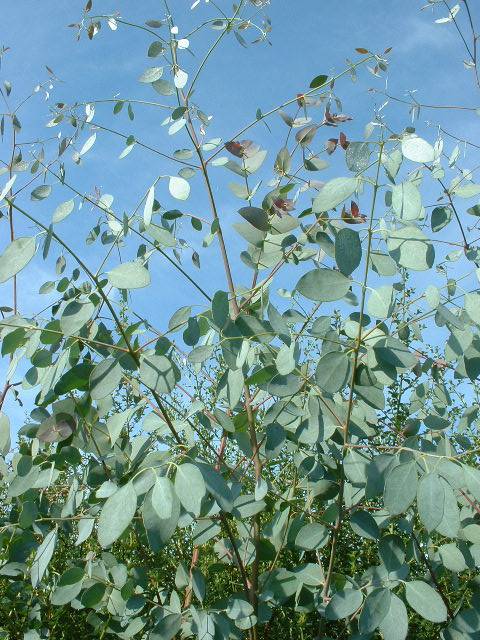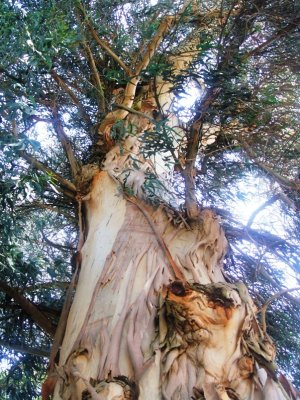Eucalyptus
This group consists of more than 400, quick-growing, tender, evergreen trees and some shrubs native to Tasmania and Australia. These unique trees can grow to giganticproportions; some species can reach heights over 400 feet in their native habitats and up to 200 feet in California. Eucalyptus trees, also popularly known as Gum trees because some species exude a gum, are fragrant and normally pest-resistant. These trees have leathery, smooth, lance-shaped leaves, which have a more rounded shape when young. Their puffball-like flowers may be red or orange and are very attractive to bees. They have no petals, but instead, numerous stamens arising from a capsule-like calyx, which give them their fluffy appearance. The attractive, colorful bark of the stems and trunks of the Eucalyptus may be dappled in gray, green, russet, or cream and may peel in sheets. Besides the decorative qualities of the trees, Eucalyptus are valued for their timber, the important oils of the leaves and shoots, tannin, which is taken from the bark of some varieties, and a resinous substance known as kino. E. parvifolia is a beautiful, medium-sized species that has beautifully colored, peeling bark. At maturity, the leaves are small, slender, and blue-green. This species tolerates alkaline soil. E. citriodora (Lemon-scented gum) is a large, quick-growing tree with smooth, white bark and lemon-scented leaves. E. coccifera (Tasmanian snow gum) is a large tree with bloomy (bloom is a powdery, waxy substance sometimes covering plants) leaves and stems, not evident in young plants. The bark peels to reveal a white trunk. E. ficifolia (Red flowering gum) is a medium-sized plant with clusters of beautiful, feathery, red flowers up to a foot long. E. pauciflora subsp. niphophila (Snow gum) is a small, fairly slow-growing tree that is covered in large, leathery, grayish-green leaves. The multi-colored trunk has been compared to the skin of a python with its green, gray, and cream bark.
Pot Cultivation
These tender trees can only be grown in warm, tropical climates. They will flourish in a variety of soils and are usually tolerant of wet sites and drought. Except E. parvifolia, most species will suffer from chlorosis (yellowing of the leaves, followed by death) in shallow, alkaline soil. Great consideration should be taken when choosing a location for these massive trees, because they will eventually overpower too small a yard. It is best to raise them from small, container grown plants and not staked. One year after they are planted, they should be pruned to the shape desired and annually thereafter in the spring or late summer. Cold, frost and harsh winds can kill a Eucalyptus, therefore they should be provided with shelter if necessary. If your plant becomes damaged or appears dead after a cold spell, do not do anything until at least the end of early summer, because new shoots may grown from any part of the tree, including the base. Shoots that grow high up will form a new branch structure and the dead wood can then be cut out. With shoots that form at the base, choose the strongest one to train to be the new trunk or choose a few to form a bushy plant.
Propagation
Seeds can be sown in June or July. Lightly shade the new plants from strong sun. They can be transplanted in the spring after they were sown. Eucalyptus trees that are chopped will form suckers from the base of the cut trees.
VARIETIES
- E. camaldulensis (Red gum);
- E. citriodora (Lemon-scented gum);
- E. coccifera (Tasmanian snow gum);
- E. dalrympleana (Mountain gum);
- E. ficifolia (Red flowering gum);
- E. globulus (Tasmanian blue gum);
- E. gunnii (Cider gum);
- E. johnstonii (Yellow gum);
- E. leucoxylon (White ironbark);
- E. parvifolia;
- E. pauciflora subsp. niphophila (Snow gum);
- E. perriniana (Spinning gum);
- E. sideroxylon (Red ironbark);
- E. urnigera (Urn gum).






